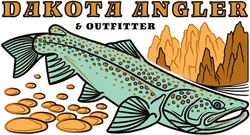Carp Fly Fishing 101 - Carp Basics
Carp Fishing is growing in popularity each year here in the United States, and for good reason - Carp are widely available to the majority of people. They grow to very large size - even in marginal Carp waters you still have a shot at a legitimate 20 pound fish many days. They're smart, wary, and selective. Many people paint the picture that carp are dumb, scum-eating trash fish, which is everything but the truth. I've grown to be somewhat of a Carp junkie myself, and for those of you looking to chase Hillbilly Bonefish for the first time, we've decided to make a "crash course" for Carp fishing!
Step number one - you've got to find some Carp. Truth is, they're very widely dispersed throughout the US. Most large reservoirs, especially on the plains, have large numbers of Carp in them. If you're having any trouble finding waters with them, just call around to local fly shops and sporting goods stores - you'll probably find someone who fishes for them, maybe hates them, or possibly shoots them with a bow, but you'll at least have a starting point to accessing waters with good numbers in them. Most larger rivers have Golden Bones in them also, including many of the popular western trout rivers such as the Bighorn and North Platte. I've been sidetracked many days chasing carp around a side channel when everyone else was fishing dries for trout. Carp are definitely partial to warmer water, slower currents, and softer bottoms than your typical trout, but there really are no rules in Carp fishing. They're about as opportunistic as fish come!
Step number two - you've found some Carp! Hooray. Now you've got to get geared up to go and tangle with some. Your big river trout rod will probably get the job done, but if you're going to fish Carp very seriously, I would recommend a 7 weight at least, if not an 8. Nine foot rods are fine. These are big, powerful fish that can put some serious strain on your gear - I've been at stalemates with medium size Carp on a saltwater 8 weight. So, don't go in under-gunned! Reel-wise, any of your modern, large arbor disc drag reels will get the job done. They generally make runs in short, powerful bursts, so you don't need a Tarpon-grade drag system, but you need more than your average trout reel as well. As far as fly lines go, there's a number of different options that vary depending on your situation. RIO's Carp line is an awesome option for spookier fish, and reasonable sized flies, i.e. 4-10. If you're battling the wind much or throwing larger bugs, I really like the RIO Power Fly line. It cuts like wind like a knife and will sail big flies out long distances easily. There's no need for sink tips in Carp fishing as far as I'm concerned - I've never run into situations that I needed one. For leader and tippet, there's several options as well. For muddier water with more snags and debris, I fish a short leader like a 7.5' 0x, with 0x or 1x tippet off the end to make it about 9' total. Fish in these situations aren't going to be line shy, so there's no need for a long leader or light tippet. For clearer water and spookier fish, I'll start with a 9'2x leader, and put a couple feet of 2x-4x fluorocarbon tippet off the end, depending on how picky the fish are being that day. Carp fight hard, so I always try and push the limit of how heavy I can go with my tippet.
Ryan







